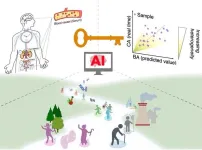(Press-News.org) Bioengineering professor and The Grainger College of Engineering’s Dean, Rashid Bashir, led a team of researchers in a project that’s resulted in new technology that offers rapid, highly sensitive detection of multi-drug-resistant bacteria and other pathogens at low concentrations.
This research was featured in an article in the Proceedings of the National Academy of Sciences of the United States of America (PNAS).
Researchers designed a CRISPR-based test that rapidly detects low levels of pathogen genetic material in blood. This is done without the need for nucleic acid amplification.
In CRISPR/Cas-based diagnostic tests, guide RNAs bind pathogen DNA or RNA, triggering Cas enzymes to become active and cleave the reporter nucleic acids that fluoresce when cleaved. However, the single CRISPR-based technique does not detect pathogens at low levels without a preamplification step.
Bashir’s team created a CRISPR-based diagnostic test that bypasses that amplification step by combining two CRISPR/Cas units in a complex called CRISPR-Cascade. One unit contains a guide RNA specific for a pathogen nucleic acid of choice and a Cas protein. When the Cas cleaves specially engineered nucleic acids that are added to the system, parts of the nucleic acids are free to bind and activate a second CRISPR/Cas, triggering a positive feedback loop that results in a high signal-to-noise ratio.
The test demonstrated unprecedented sensitivity. It also detected multi-drug-resistant Staphylococcus aureus DNA without prior amplification at concentrations that were orders of magnitude lower than the limit of a test using a single Cas. The test provided a simple “yes/no” result for the presence of any one pathogen in samples spiked with four common bloodstream pathogens.
The researchers said these results could be used toward developing highly sensitive CRISPR-based diagnostic tests that can detect pathogens in minutes without nucleic acid amplification.
END
New CRISPR-based diagnostic test detects pathogens in blood without amplification
2025-03-14
ELSE PRESS RELEASES FROM THIS DATE:
Immunotherapy may boost KRAS-targeted therapy in pancreatic cancer
2025-03-14
PHILADELPHIA – Adding immunotherapy to a new type of inhibitor that targets multiple forms of the cancer-causing gene mutation KRAS kept pancreatic cancer at bay in preclinical models for significantly longer than the same targeted therapy by itself, according to researchers from the Perelman School of Medicine at the University of Pennsylvania and Penn Medicine’s Abramson Cancer Center. The results, published in Cancer Discovery, prime the combination strategy for future clinical trials.
Combatting the “undruggable” ...
Growing solar: Optimizing agrivoltaic systems for crops and clean energy
2025-03-14
Agrivoltaic systems, which combine solar power generation with agricultural practices, offer a promising solution to the growing demand for both renewable energy and food production. By integrating solar panels with crops, these systems not only address the land use conflict between agriculture and energy production, but they also provide important benefits such as reducing crop water stress and offering protection against extreme weather events. In addition, agrivoltaics can contribute to biodiversity by providing pollinator habitats and forage production. ...
Scientists discover how to reactivate cancer’s molecular “kill switch”
2025-03-14
Alternative RNA splicing is like a movie editor cutting and rearranging scenes from the same footage to create different versions of a film. By selecting which scenes to keep and which to leave out, the editor can produce a drama, a comedy, or even a thriller—all from the same raw material. Similarly, cells splice RNA in different ways to produce a variety of proteins from a single gene, fine-tuning their function based on need. However, when cancer rewrites the script, this process goes awry, fueling tumor growth and survival.
In a recent study reported in the Feb. 15 issue of Nature ...
YouTube influencers: gaming’s best friend or worst enemy?
2025-03-14
New INFORMS Marketing Science Study Key Takeaways:
YouTube influencers increase player engagement and playtime but often reduce game purchases, especially for story-driven games.
A unique event in YouTube’s history, the “Adpocalypse,” allowed researchers to measure the causal impact of influencer content, revealing its complex effects on game sales and usage.
Game developers must align their business models with influencer marketing, because games with in-game purchases benefit from exposure, while ...
uOttawa scientists use light to unlock secret of atoms
2025-03-14
A team of researchers from the University of Ottawa has made significant strides in understanding the ionization of atoms and molecules, a fundamental process in physics that has implications for various fields including x-ray generation and plasma physics.
Think about atoms - the building blocks of everything around us. Sometimes, they lose their electrons and become charged particles (that's ionization). It happens in lightning, in plasma TVs, and even in the northern lights. Until now, scientists thought they could only control this process in limited ways.
Led by Ravi Bhardwaj, Full Professor at uOttawa’s Department of Physics, and PhD student Jean-Luc Begin, in collaboration ...
NJIT mathematician to help map Earth's last frontier with Navy grant
2025-03-14
We’ve mapped nearly all of Mars’ surface from orbit, yet we know less about Earth’s ocean floor — almost 75% remains unmapped in high resolution.
This terrestrial blind spot is driving NJIT Mathematics Professor Eliza Michalopoulou’s latest research, funded by the Office of Naval Research (ONR). The project aims to improve how scientists explore the vast, uncharted ocean floor through sound.
“Mapping the seabed is a challenging endeavor due to the extreme conditions,” said Michalopoulou, ...
NASA atmospheric wave-studying mission releases data from first 3,000 orbits
2025-03-14
Following the 3,000th orbit of NASA’s AWE (Atmospheric Waves Experiment) aboard the International Space Station, researchers publicly released the mission’s first trove of scientific data, crucial to investigate how and why subtle changes in Earth’s atmosphere cause disturbances, as well as how these atmospheric disturbances impact technological systems on the ground and in space.
“We’ve released the first 3,000 orbits of data collected by the AWE instrument in space and transmitted back to Earth,” said Ludger Scherliess, principal investigator for the mission and physics professor at Utah State University. “This is a view of atmospheric ...
‘Microlightning’ in water droplets may have sparked life on Earth
2025-03-14
Life may not have begun with a dramatic lightning strike into the ocean but from many smaller “microlightning” exchanges among water droplets from crashing waterfalls or breaking waves.
New research from Stanford University shows that water sprayed into a mixture of gases thought to be present in Earth’s early atmosphere can lead to the formation of organic molecules with carbon-nitrogen bonds, including uracil, one of the components of DNA and RNA.
The study, published in the journal Science Advances, adds evidence – and a new angle – to the much-disputed Miller-Urey ...
Smoke from wildland-urban interface fires more deadly than remote wildfires
2025-03-14
EMBARGOED until Friday, March 14 at 2:00 p.m. Eastern Time (12 noon MT)
Contacts:
David Hosansky, NSF NCAR and UCAR Manager of Media Relations
hosansky@ucar.edu
303-497-8611
Audrey Merket, NSF NCAR and UCAR Science Writer and Public Information Officer
amerket@ucar.edu
303-497-8293
The smoke from fires that blaze through the wildland-urban interface (WUI) has far greater health impacts than smoke from wildfires in remote areas, new research finds.
The study, published this week in Science Advances, estimates that emissions from WUI fires are proportionately about three times more likely to lead ...
What’s your body really worth? New AI model reveals your true biological age from 5 drops of blood
2025-03-14
Osaka-Japan - We all know someone who seems to defy aging—people who look younger than their peers despite being the same age. What’s their secret? Scientists at Osaka University (Japan) may have found a way to quantify this difference. By incorporating hormone (steroid) metabolism pathways into an AI-driven model, they have developed a new system to estimate a person’s biological age a measure of how well their body has aged, rather than just counting the years since birth.
Using just five drops of ...



